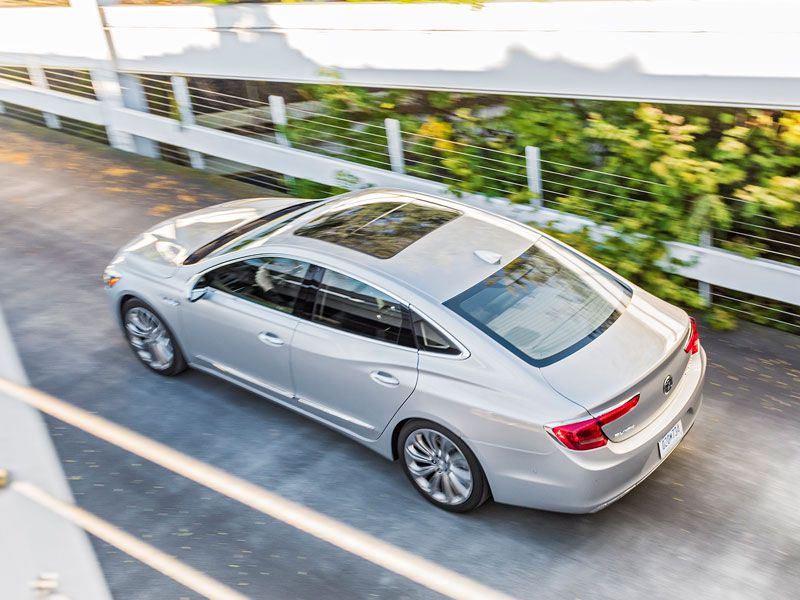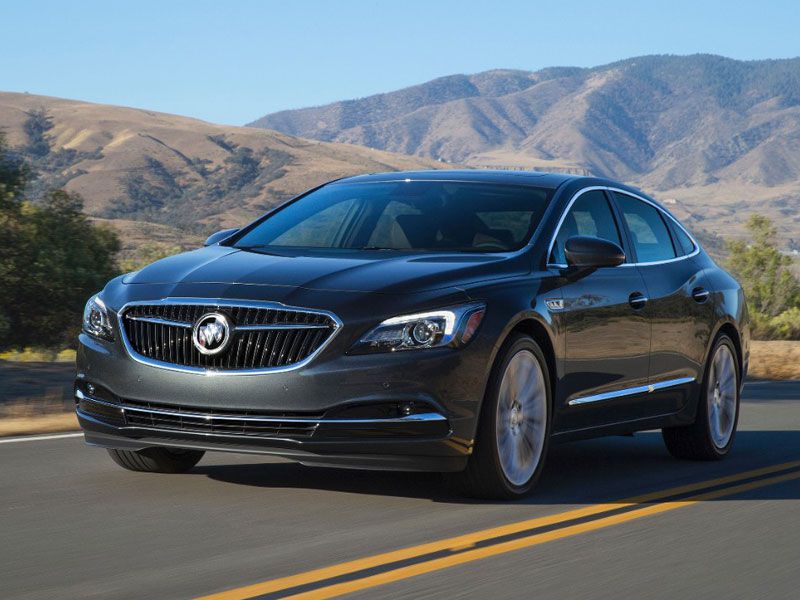Recent Articles
Popular Makes
Body Types
2017 Buick LaCrosse vs 2017 Toyota Avalon: Which is Best?

Buick LaCrosse vs Toyota Avalon
Although the two vehicles may not seem to have much in common at first glance, plenty of customers want to know which is best, the 2017 Buick LaCrosse or the 2017 Toyota Avalon. That’s because the affordable luxury in the LaCrosse, and the high-end mainstream positioning for the Avalon, can often appeal to the same group of shoppers. In both cases, drivers enjoy a surprisingly premium ownership experience without breaking the bank. It’s also worth noting that both are relatively fresh faces, with the LaCrosse all-new for 2017 and the Avalon significantly updated last year. That said, there are some major differences between the two cars, from their approach to performance, their focus on technologies, and to the different levels of content discussed in the following slides.
Exterior Design and Standard Content
If you’re looking for a car that matches upscale content with an upscale appearance, the 2017 Buick LaCrosse is a clear choice. The Buick’s profile is especially sophisticated, showing a long, graceful curve that flows back over the rear wheels, and the grille is elegant yet understated, with a full-width lower-intake area for an aggressive touch. The 2017 Toyota Avalon, in contrast, looks like a large Toyota. The LaCrosse’s standard 18-inch aluminum-alloy wheels are larger than the Avalon’s as well, and its standard high-intensity discharge headlamps are optional for the Avalon. Both cars come with standard heated mirrors, daytime running lights and LED taillights, but only the LaCrosse supplies standard mirror-mounted approach lighting and standard LEDs for its daytime running lights.

Photo by General Motors
Interior Design and Content
Shoppers will find impressive cabin designs for both the 2017 Toyota Avalon and 2017 Buick LaCrosse, including a similar approach to the center-stack layout, which has the control interface angled backward to open up the front row. The Avalon has a more driver-oriented focus, however, while the LaCrosse again relies on long, flowing lines and an infotainment-screen frame that mimics the look of its front grille. Yet if there’s no clear leader in terms of design, the Avalon has a definite, difference-making advantage in standard content. For example, even as each car furnishes a standard leather-wrapped multi-function steering wheel and dual-zone automatic climate control, it’s the Avalon that complements that feature with standard leather seating and standard heating for the driver and front-seat passenger.

Photo by Toyota
Interior Space
A key reason that people shop for the 2017 Buick LaCrosse and 2017 Toyota Avalon has to do with their dimensions. These are, as mentioned, full-size sedans, and that means they serve up full-size accommodations for five passengers. It’s just that the Avalon carves out a little more space for passengers and packages alike. How little? Well, total passenger and trunk volume for the Avalon are 103.6 cubic feet and 16 cubic feet respectively, and for the LaCrosse those measurements are 102 and 15. Digging deeper into the measurements, the Avalon also has more standard front headroom, rear headroom, and front legroom. Keep in mind, though, that both vehicles are within .8 inches of each other in all measures.

Photo by Toyota
Interior Luxury
If you’re getting tense while trying to decide which is best, remember this - only the LaCrosse offers a relaxing massage function for the driver and front-seat passenger. French-stitched soft-touch surfaces also cover the Buick’s seats, armrests, instrument panel and center console, for a more upscale ambiance in the cabin. On the Avalon’s side of the ledger, it offers heat for the rear seats, something that’s missing from the LaCrosse. Still, a swankier environment gives the win to the LaCrosse despite the fact that both cars are available with perforated leather seating surfaces, heated and ventilated eight-way power-adjustable front seats, and a heated and leather-wrapped multi-function steering wheel—which, with the LaCrosse, can be paired with a power-adjustable column.

Photo by Buick
Standard Powertrains
The more advanced standard powertrain for the 2017 Buick LaCrosse actually creates two benefits for owners, since it’s not only more powerful, it’s also more fuel-efficient. Now, both standard engines are 3.6-liter V6s, but the one for the Buick makes 309 horsepower and 268 pound-feet of torque, while the standard V6 for the Avalon produces 41 less horsepower and 20 fewer lb.-ft. of torque. Then, thanks to technologies like a stop/start system, cylinder deactivation, and an eight-speed automatic transmission, the LaCrosse earns EPA ratings of 21 mpg city/31 mpg highway/25 mpg combined. The Avalon, when equipped with a standard six-speed automatic transmission, can post an EPA line of 21 mpg city/30 mpg highway/24 mpg combined.

Photo by Buick
Optional Powertrains
The available powertrains for the 2017 Toyota Avalon and 2017 Buick LaCrosse deliver two completely different driving experiences that are likely to appeal to two different audiences. The Avalon follows in a long line of Toyota hybrid vehicles by serving up a high-efficiency trim that can achieve fuel-economy grades of 40 mpg city/39 mpg highway/40 mpg combined. But the LaCrosse takes its cues from premium sport sedans and can provide features such as a new-for-2017 dual-clutch all-wheel-drive system, an active suspension with electronically controlled continuous damping, electric power steering with lead/pull compensation, and Buick’s HiPer Strut front suspension. Frankly, that’s the kind of hardware that folks expect from their semi-luxury cars, so we’ll chalk up another win for the LaCrosse in this category.

Photo by Buick
Safety Ratings and Technology
It’s a close call as to whether the Avalon or LaCrosse is the leader in this category. True, the Avalon checks in with an initial advantage in standard safety tech, backed by a rearview camera, adaptive cruise control, lane-departure alert with steering assistance, automatic high beams, and a pre-collision system with pedestrian detection. But all of that is offered by the LaCrosse, which goes on to deliver a Safety Alert driver’s seat, too, for vibration-based warnings. In terms of ratings, both have 5-Star Overall Safety Scores from the National Highway Traffic Safety Administration (NHTSA) and Top Safety Pick certification from the Insurance Institute for Highway Safety (IIHS.) On the other hand, only the Avalon is recognized with the IIHS “+” designation, and only the LaCrosse has 5 Star NHTSA grades in all three phases of crash testing.

Photo by Toyota
Infotainment Technology
With a mobile Wi-Fi hotspot, Android Auto, Apple CarPlay, and an eight-inch touchscreen all standard for the 2017 Buick LaCrosse—and unavailable in the 2017 Toyota Avalon—the choice for tech-friendly customers is a simple one. The LaCrosse also provides further Buick-only benefits such as a head-up display and standard active noise cancellation (the latter as part of the brand’s typical attention to ensuring a quiet cabin.) As for tech resources in common, each vehicle can be ordered with integrated navigation, wireless charging, Bluetooth connectivity, voice recognition, USB ports, SiriusXM Satellite Radio, and 11-speaker premium sound systems. Buick-based audiophiles can opt for a Bose Centerpoint Surround-sound setup, while the Avalon is available with JBL components including high-efficiency GreenEdge speakers.

Photo by Buick
Pricing and Value
We’ll get into the details on the next page, but if you’ve been keeping score so far, you might be surprised to find out that the 2017 Buick LaCrosse is less expensive than the 2017 Toyota Avalon. Although it is a negligible difference - the LaCrosse starts at $32,065 and the MSRP of the Avalon is $33,300. As a result, the price of admission for the Avalon is $1,235 (3.8 percent) higher than for the LaCrosse, but keep in mind, the Avalon does have more standard safety tech and leather seats, though the LaCrosse is more powerful and has more standard connectivity features. The pricing difference between the Buick and Toyota range-toppers is smaller, but it still tilts in favor of the LaCrosse Premium by $335.

Photo by Buick
The Verdict
So, which is best, the 2017 Buick LaCrosse or 2017 Toyota Avalon? In the end, these are two well-matched cars, each with their own unique strengths and weaknesses. The Avalon, for instance, stands out for standard safety content, a better-appointed standard cabin, and per the IIHS, better headlights that enable a full Top Safety Pick+ rating. The LaCrosse balances its lower level of standard driver-assistance technology with more standard connectivity features, and as mentioned, while the LaCrosse can at least offer more safety resources, the Avalon doesn’t furnish the latest connectivity capability at all. The two cars also have very different ideas about their optional powertrains.
Our choice? The Buick LaCrosse best lives up to our ideas about what makes a successful near-premium sedan.

Photo by Buick